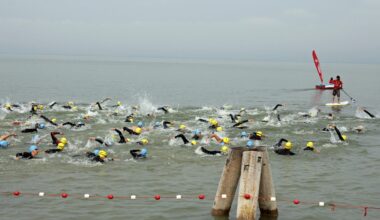Advanced Lower Body Home Workout Techniques for Muscle Growth
The lower body plays a crucial role in overall fitness and strength. To maximize muscle growth, advanced techniques are essential. Start with compound movements like squats and deadlifts, as they engage multiple muscle groups, ensuring efficient workouts. Variations such as sumo squats and Bulgarian split squats can effectively target different muscles and keep the workouts challenging. Additionally, incorporating resistance bands provides extra tension that enhances the workout’s efficacy. They can be used in many exercises, including lunges and glute bridges. Progressive overload should be your mantra; gradually increase weights or resistance levels to stimulate muscle growth. Pay close attention to proper form during each exercise, as incorrect posture can lead to injuries and reduced effectiveness. Tracking your workouts also plays a significant role, helping you recognize progress and adjust your routine accordingly. Lastly, ensure adequate rest days for recovery, which are vital for muscle development. Without recovery, muscle gains can plateau. Ultimately, consistency paired with the right techniques will yield significant results in your lower body workout journey.
Strength training is more effective when incorporating unilateral exercises. These target one side of the body at a time, promoting muscle balance and improving coordination, which is often neglected during bilateral workouts. Exercises like single-leg deadlifts and pistol squats not only challenge stability but also increase the intensity of the workout. To further enhance your lower body routine, embrace circuit training. This method involves performing a series of exercises back-to-back with minimal rest, keeping your heart rate elevated, which promotes both muscle growth and fat loss. For instance, you might alternate between lunges, leg lifts, and squats. This approach also brings variety, preventing workout monotony. Similarly, plyometric movements such as jump squats and box jumps can dramatically improve muscular explosiveness. They engage fast-twitch muscle fibers, essential for strength and athleticism. Combining strength, endurance, and plyometric exercises into your routine creates a multifaceted approach to lower body training. Always remember to warm up appropriately before beginning your sessions to avoid injuries and optimize performance! Cooling down afterward is equally important to allow muscles to recover.
Use of Advanced Equipment
Incorporating advanced equipment can greatly enhance your lower body workouts at home. Kettlebells, resistance bands, and stability balls are fantastic tools for adding variety and challenge. Kettlebell swings, for example, target your hamstrings, glutes, and core while providing a cardiovascular workout as well. Resistance bands add extra tension to basic exercises like squats, making them more effective. Many people underestimate the benefits of stability balls; they improve your core stability while performing exercises like wall squats. Adding weights to these movements intensifies your workouts. Consider investing in a suspension trainer to diversify your routine further. This equipment allows you to perform bodyweight exercises effectively, enhancing muscle engagement due to instability. Always ensure you select weights that challenge you without compromising your form. Resistance training is essential for muscle growth, focusing on different muscle groups through varied movements. In turn, this can lead to improved performance in other activities and sports. Pay attention to your body’s signals to prevent injury and adapt your routine based on your personal fitness level. Incorporating these elements will significantly enhance muscle growth results in your lower body!
Rest and recovery play pivotal roles in muscle growth and overall fitness. Without adequate recovery, muscle fatigue can accumulate, hindering your ability to train effectively. Prioritize rest days in your workout schedule to allow time for your muscles to repair and strengthen. During these periods, engaging in light activities like walking or stretching can promote recovery without overexerting yourself. Nutrition is equally critical. Incorporating enough protein into your diet fuels muscle repair and growth. Aim for quality sources like lean meats, dairy, legumes, and protein supplements if necessary. Hydration should not be overlooked, as water regulates body temperature and aids in overall performance during workouts. Electrolytes help replenish lost minerals due to sweating, supporting muscle function and recovery. Tracking your nutrition can be helpful; consider keeping a food journal to ensure you are meeting your dietary needs. Adjust your dietary intake based on workout intensity and frequency, providing enough energy. Listening to your body can help mitigate the risks of overtraining, fatigue, and injury. This will ultimately enable continued progress toward your lower body fitness goals without setbacks.
Implementing Progressive Overload
Progressive overload is a cornerstone strategy for muscle growth. It involves gradually increasing stress on your muscles to stimulate adaptation and strength improvement. Start by increasing weights or resistance gradually. If you’re performing squats with a dumbbell, add an extra 5 pounds once you feel comfortable completing your reps. This principle also applies to bodyweight exercises; increase repetitions or sets over time. Incorporate tempo changes into your routine, focusing on slowing down your eccentric phase (the lowering part of a movement) to maximize time under tension. This technique can effectively lead to muscle hypertrophy. Ensure you vary your workouts by including new exercises every few weeks to avoid plateauing. Different movements challenge muscles in various ways, preventing adaptation. Consider changing the angle or position of movements, for instance, switching from standard lunges to lateral lunges. Regularly assessing your progress is essential, so keep notes on weights, sets, and repetitions. This practice will enable you to recognize patterns in your training and refine your approach. Consistency with progressive overload will be crucial for your lower body muscle growth journey, propelling you toward your fitness aspirations!
Form and technique cannot be overstated when performing lower body workouts. Incorrect posture can lead to injuries and ineffective muscle engagement, undermining your strength goals. Focus on maintaining a neutral spine and engaging your core during exercises. Be mindful of your knees during squats or lunges—ensure they track over your toes and don’t cave inward. Performing exercises in front of a mirror is an excellent way to monitor and correct your form. If you’re new to a movement, consider practicing without weights to establish a solid foundation. This will help you gain confidence, improving your performance under heavier loads. Additionally, investing in an online coaching program can provide personalized feedback to enhance your form. Several apps and platforms allow for virtual coaching sessions or video submissions for critique. Don’t rush through exercises; control your speed and prioritize smooth transitions between movements. Conduct regular assessments of your form, as habits may develop over time. Remember, prioritizing form initially sets the stage for progress and long-term success in your advanced lower body workouts.
Motivation and Mindset
Maintaining motivation is essential in any fitness journey, especially in strength training for the lower body. Set specific, measurable, achievable, relevant, and time-bound (SMART) goals to guide your training. Whether aiming to increase the weight lifted or improve form, establishing clear objectives keeps you focused. Tracking your progress can serve as motivation; journal workouts and note improvements. Surround yourself with a supportive community, whether friends or online groups, for accountability and encouragement. Online platforms often have groups dedicated to strengthening your lower body. Exploring new exercises keeps your routine fresh and exciting, reducing the temptation to skip workouts. Celebrate small victories along the way—recognizing progress can greatly enhance motivation. Self-talk is equally powerful; replace negative thoughts with positive affirmations that reinforce your capabilities. Envisioning your goals and reflecting on the journey can motivate you. Incorporate a fun, upbeat playlist during your sessions to boost energy levels and enjoyment. Lastly, remember that fitness peaks and valleys are part of the process. Staying committed during challenging days will ultimately lead to success, transforming not just your body but also your overall mindset.


